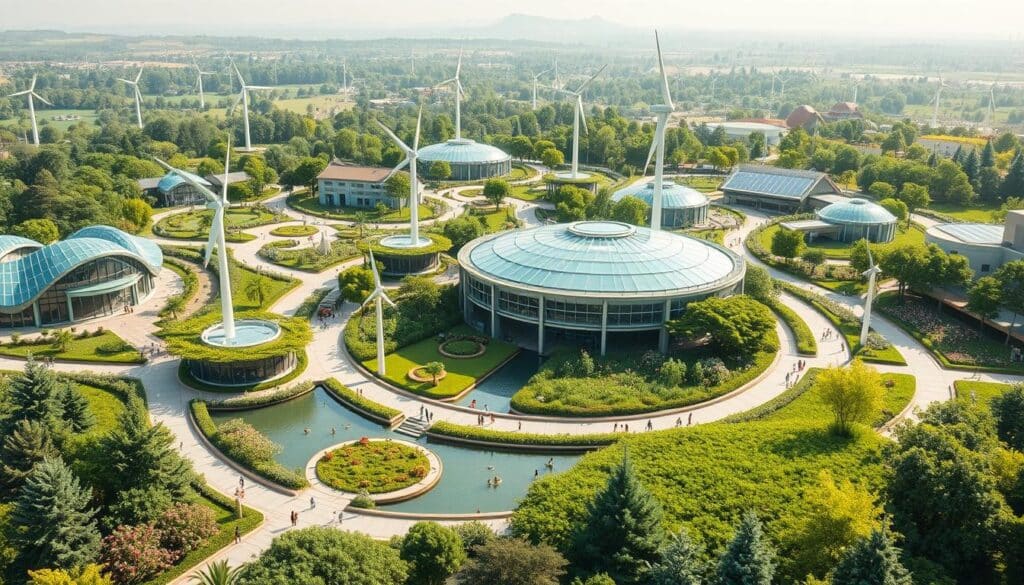The link between business and the environment is key for sustainable growth and protecting our planet. Businesses must work together, not alone. They need to focus on the well-being of communities, nature, and other stakeholders.
This approach is vital for changing poverty into prosperity and building a better future. By seeing themselves as part of bigger ecosystems, companies can work with local communities. They can also use circular economy practices and technology to tackle environmental issues together.
Embracing sustainable synergy is more than a duty; it’s a chance for lasting success. It helps reduce risks, sparks new ideas, and improves life for everyone. This way, businesses can thrive while caring for our planet.
Key Takeaways
- The interconnection between business and the environment is essential for sustainable growth and environmental protection.
- Businesses must embrace synergistic relationships to align their interests with the well-being of communities, nature, and other stakeholders.
- Recognizing businesses as interconnected components of larger ecosystems enables collaboration, circular economy practices, and technology-driven solutions.
- Sustainable synergy is an opportunity to create long-term prosperity, reduce risks, stimulate innovation, and enhance the quality of life.
- Embracing sustainable synergy is not just a responsibility, but a pathway to a regenerative future.
Embracing Synergistic Relationships for Environmental and Economic Prosperity
Synergy is when different parts work together to create something greater. This idea is found in nature and can help businesses. They can make a positive environmental impact and still make money.
Seeing businesses as part of a bigger ecosystem helps. This way, companies can work for the good of everyone and the planet. This creates a cycle where success helps both society and the environment.
The Power of Synergy: Transcending Silos
Synergy breaks down barriers and leads to better solutions. It helps tackle environmental and economic challenges in a complete way. When businesses connect with nature, they can grow in a way that’s good for everyone.
Fostering Local Synergies: Engaging Communities and Preserving Cultures
Working with local communities and cultures is important. It builds strength and gives power to people. By teaming up with local stakeholders, businesses can create plans that fit the community’s needs.
This way, they can protect the natural environment and keep cultural identities alive.
| Benefits of Synergistic Relationships | Environmental Impact | Economic Impact |
|---|---|---|
| Reduced carbon footprint | Lower greenhouse gas emissions | Cost savings through improved resource efficiency |
| Increased resource efficiency | Reduced waste and pollution | Competitive advantage through innovation |
| Innovative sustainable business models | Preservation of natural ecosystems | Long-term business resilience |
By embracing synergy, businesses can achieve both environmental and economic success. They move beyond old limits and adopt a more complete approach to sustainability.
Circular Economy: A Paradigm Shift Towards Sustainable Synergies

The circular economy is a big change in how businesses think about being green. It’s a new way that moves away from taking, making, and wasting. Instead, it keeps resources going in a loop, making things last longer.
Companies that use circular practices can cut down on pollution. They also find new ways to make money by turning old materials into something new.
Switching to a circular economy has big benefits. It can cut down greenhouse gas emissions by 25%. It also helps reduce plastic waste in oceans by over 80%. Governments could save $70 billion and businesses could save $4.5 trillion.
Businesses are now seeing the need to protect the environment. They’re moving towards a circular economy to help the planet. This change helps everyone involved, making sure we all do well together.
The circular economy is a bright spot for a greener future. It shows how innovation and teamwork can make a big difference. It’s a way for businesses to be part of the solution, not just the problem.
| Circular Economy Metrics | Potential Impact |
|---|---|
| Reduction in Greenhouse Gas Emissions | 25% decrease |
| Reduction in Plastics Entering Oceans | Over 80% decrease |
| Potential Cost Savings for Governments | Approximately $70 billion |
| Potential Savings Exceeding | $4.5 trillion |
The circular economy is a beacon of hope for a greener future. It shows how innovation, teamwork, and caring for the environment can work together. This way, businesses can help create a better, more inclusive economy for everyone.
“45% of global greenhouse gas emissions cannot be addressed by energy efficiency and renewable energy alone, stressing the need for strategies such as transitioning to a circular economy.”
– Ellen MacArthur Foundation
Business And The Environment: Leveraging Technology for Collaborative Solutions

In our world, technology is key in bringing businesses and the environment together. Tools like collaboration platforms, data-sharing, and digital markets help connect them. They allow for the sharing of knowledge, resources, and green solutions.
Collaboration Platforms: Connecting Businesses and Local Stakeholders
Platforms are now linking businesses with local communities. They help everyone understand environmental issues and how to solve them. These platforms let businesses share ideas and work together to tackle big environmental problems.
Data-Sharing Initiatives: Enhancing Transparency and Knowledge Exchange
Data-sharing is changing how businesses tackle sustainability. By sharing data, companies can be more open and find new ways to work together. This leads to better solutions for reducing carbon and greenhouse gas emissions.
Technology helps companies break down old barriers. They can now work together to solve environmental issues, share information, and drive progress. This leads to a stronger, more sustainable economy for everyone.
Sector Hybridization, Resource Circularity, and Collocated Facilities

Businesses are now looking at new ways to be sustainable. They’re using sector hybridization, resource circularity, and collocated facilities. These strategies help the environment and create value for everyone.
Sector Hybridization: Merging Diverse Industries for Shared Value
Sector hybridization brings together different industries for sustainability. For example, some companies use subway heat to warm buildings. This cuts down on fossil fuel use and benefits the economy.
Resource Circularity: Transforming Waste into Opportunity
Resource circularity turns waste into something useful. Businesses are finding ways to reuse resources instead of throwing them away. This approach helps reduce carbon emissions and supports a greener future.
Collocated Facilities: Optimizing Space and Reducing Environmental Footprint
Collocated facilities, like solar parking lots, show how to use space wisely. They combine systems to cut down on environmental harm. This is a great example of how business and nature can work together.
As business leaders face the urgent challenges posed by climate change in 2024, the need for sustainability has never been more critical. Companies are increasingly focusing on sustainable business operations that minimize their environmental impact while promoting economic growth. By adopting innovative business models that prioritize the responsible use of natural resources, organizations can significantly reduce their carbon footprint and carbon emissions, aligning with ESG (Environmental, Social, and Governance) criteria. The energy transition from fossil fuels to renewable sources is essential for achieving sustainable development and mitigating the negative impacts of greenhouse gas emissions. Furthermore, an inclusive business strategy that considers the social impact on all stakeholders is vital for fostering a resilient supply chain and enhancing their environmental programs. As businesses strive to become more sustainable, they must engage in practices that not only support economic growth but also contribute positively to the planet and society.
At Harvard Business School, the intersection of business and the environment is increasingly becoming a focal point, particularly in addressing climate change and its effects on the natural environment. In the fourth episode of our series on business and climate, we explore the critical role of media in shaping narratives around sustainability issues. Joel Makower, co-founder and chair of Trellis, a leading independent media platform focused on the intersection of business and climate action, has been a pioneer in the climate media space since he founded The Green Business Letter in 1991. With a career spanning over three decades, he offers valuable advice for future business leaders looking to make an impact in climate and environmental sustainability. By fostering environmentally friendly business practices and corporate social responsibility, companies can protect the environment while addressing environmental and social challenges, including greenhouse gas emissions and natural disasters. This strategy of a niche climate-focused approach not only enhances the business strategy of organizations but also promotes sustainability initiatives that mitigate negative environmental harm. In collaboration with the Sustainable Entertainment Alliance and other stakeholders, businesses must implement initiatives that reduce their carbon footprint and engage in environmental management, thus creating a positive impact across different parts of the world. Through effective storytelling around climate change and sustainable business, we can inspire a collective movement towards a more sustainable future.
These strategies show how businesses can make a positive impact. By using sector hybridization, resource circularity, and collocated facilities, companies can help create a better world for everyone.
“Sustainable synergies are not just about reducing environmental impact; they’re about creating shared value and unlocking new opportunities for businesses and communities alike.”
Also Read : What Is A Global MBA In Sustainability And Why Is It Important?
Conclusion: Embracing Sustainable Synergy for a Regenerative Future
Embracing sustainable synergy is key for a future where everyone and the planet thrive together. By seeing how business and the environment are connected, companies can work for the good of both. This move from old, harmful ways to new, sustainable ones needs teamwork and smart use of synergies.
As businesses, leaders, and people change, we can make our economy better. We can use clean energy, make sustainable supply chains, and add social impact initiatives to our work. This can lead to a greener, fairer economy for everyone.
With AI, data-sharing, and mixing sectors, companies can use tech and teamwork to solve big environmental challenges. As ESG-focused investments and the SDGs grow, businesses are key in making a sustainable, strong, and fair future.
FAQs
Q: What is the significance of sustainability in business according to Harvard Business School?
A: Sustainability is crucial for business as it addresses the intersection of business and the environment, helping organizations mitigate their environmental impact and adapt to climate change while pursuing economic growth and social impact.
Q: How can businesses become more sustainable in their operations?
A: Businesses can become more sustainable by adopting environmentally friendly practices, reducing their carbon footprint, implementing an environment program, and rethinking their supply chain to promote sustainable development.
Q: What role do business leaders play in addressing climate change?
A: Business leaders play a vital role in addressing climate change by integrating sustainability into their business strategy, leading initiatives that reduce greenhouse gas emissions, and ensuring that their companies are prepared for the energy transition.
Q: What are the negative impacts of ignoring sustainability in business practices?
A: Ignoring sustainability can lead to significant negative impacts, including increased carbon emissions, depletion of natural resources, and potential damage to a company’s reputation and stakeholder trust.
Q: What is the importance of environmental management in a business setting?
A: Environmental management is essential as it helps businesses identify, monitor, and mitigate their environmental impact, thus aligning their operations with sustainability goals and addressing environmental and social challenges.
Q: How does Harvard Business School support sustainable business models?
A: Harvard Business School supports sustainable business models through its research and education initiatives, including a series on business and climate, which provides insights on how to effectively incorporate sustainability into business strategies.
Q: What is the connection between corporate social responsibility (CSR) and sustainability?
A: Corporate social responsibility (CSR) is closely linked to sustainability as it encompasses a company’s commitment to conducting business in an ethical manner that considers the environmental and social impacts of its operations, ultimately supporting sustainable development.
Q: How can companies measure their progress towards sustainability goals?
A: Companies can measure their progress toward sustainability goals by tracking key performance indicators (KPIs) related to their carbon footprint, resource consumption, and the effectiveness of their environmental initiatives, ensuring alignment with their overall sustainability strategy.
Q: What challenges do businesses face in implementing sustainable practices?
A: Businesses face several challenges in implementing sustainable practices, including resistance to change, the need for investment in new technologies, balancing economic growth with environmental goals, and navigating the complexities of stakeholder expectations.
Q: How can businesses effectively communicate their sustainability efforts to stakeholders?
A: Businesses can effectively communicate their sustainability efforts to stakeholders by clearly reporting on their environmental goals, sharing success stories, engaging in transparent dialogue, and showcasing their commitment to addressing climate change through targeted initiatives.


